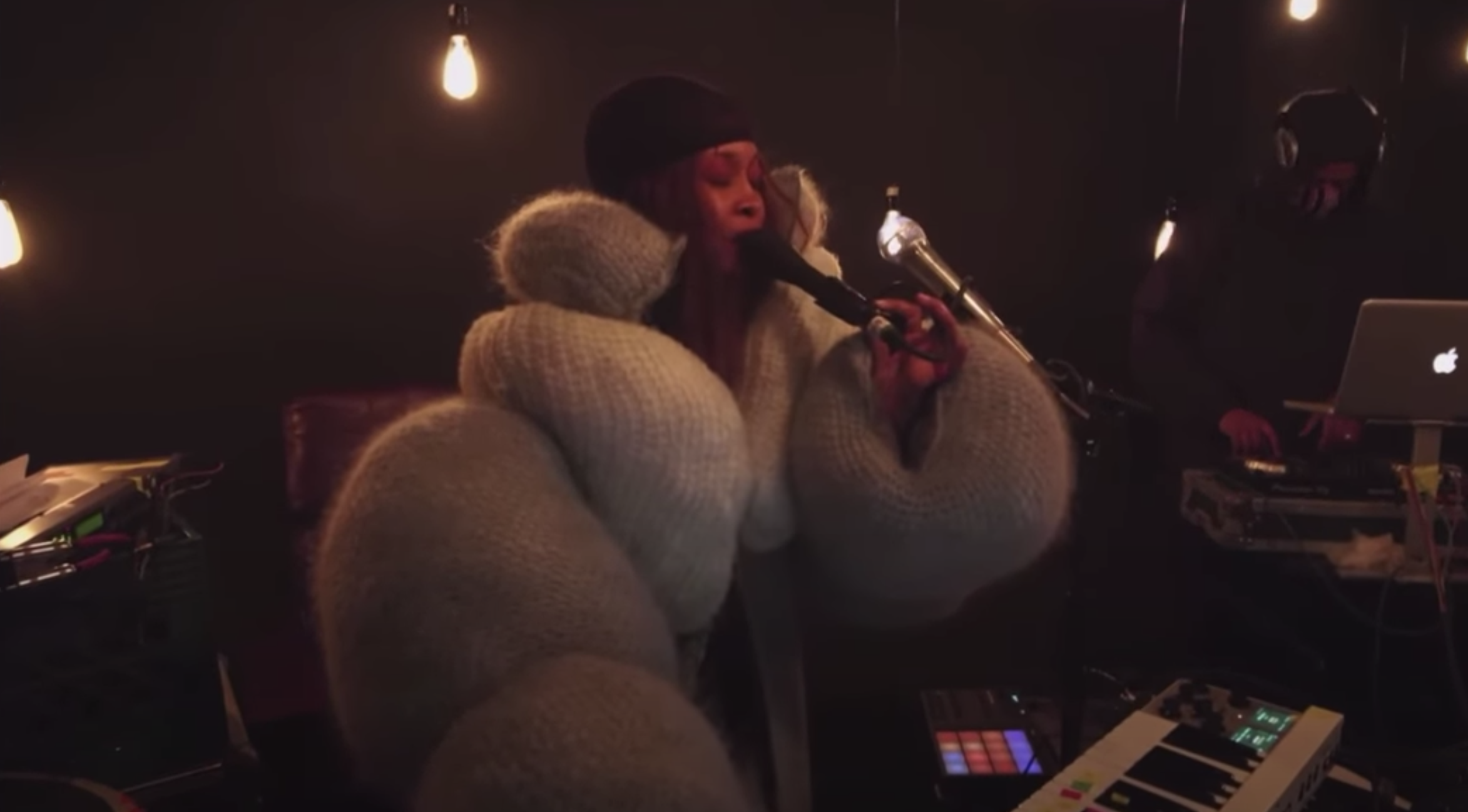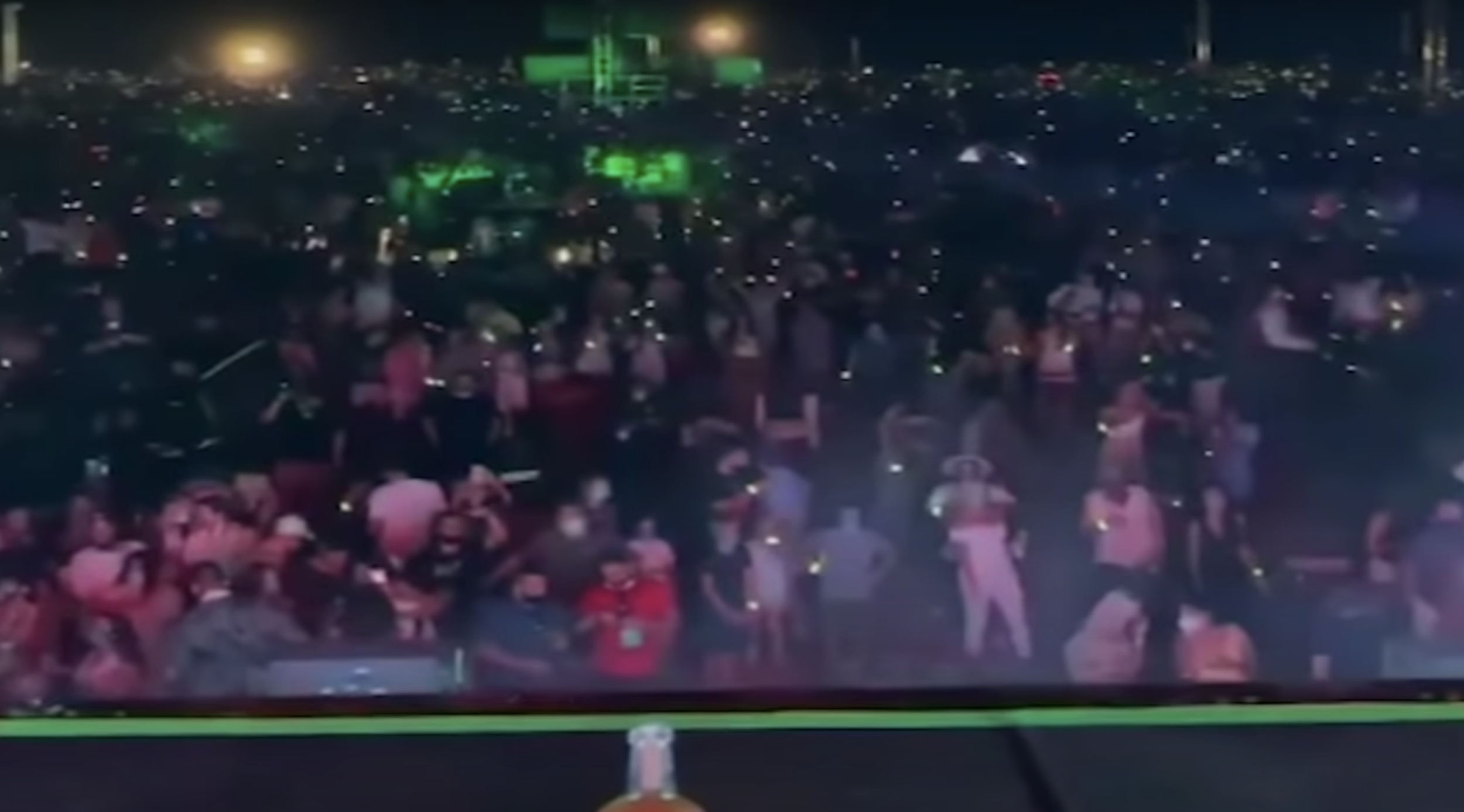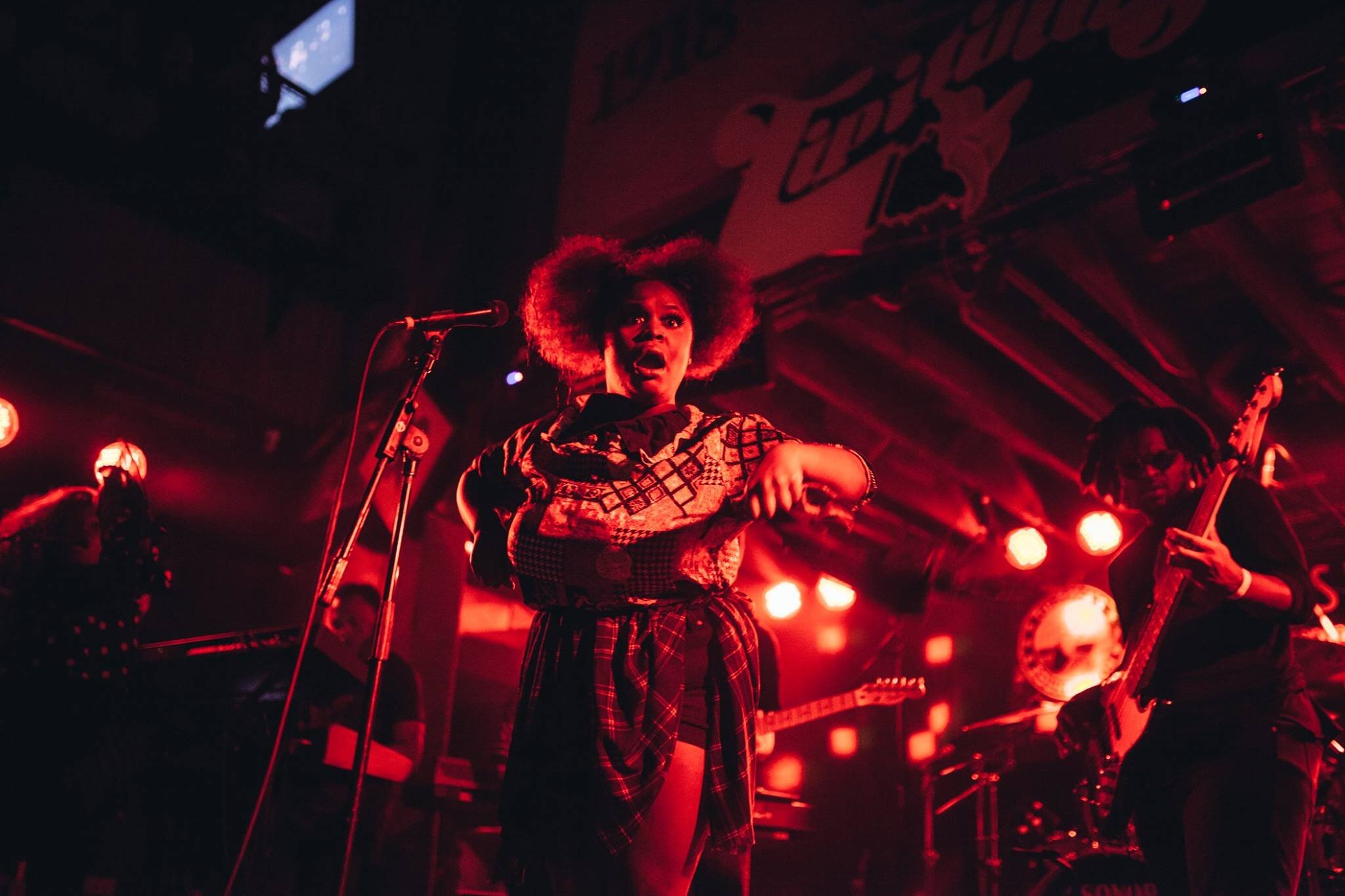Live-Streams Will Outlive Drive-In Concerts

Erin McKeown, from “Cabin Fever”
Live-streamed content has a future, but not necessarily in digital busking, and maybe not in concerts.
As America loses its mind, concerts take place. Recently, ‘80s hair metal band Great White continued to show a poor grasp of risk assessment and played a mask-free concert without social distancing in North Dakota. Earlier this month, the July Mini-Fest—originally know as the Herd Immunity Fest—took place in Wisconsin, the festival’s sole concession to COVID-19 was only allowing 2,500 attendees in a space that would ordinarily accommodate 10,000, giving festers the space to socially distance if they so desire.
Such concerts are anomalies, though. Drive-in concerts are more common, and this Friday, the NOLA Drive-In Summer Concert Series in the Lakefront Arena parking lot will conclude with a set by The Revivalists. Still, such shows are limited by the number of socially distanced cars a space can accommodate—200 or so at Lakefront Arena—as well as the spacious presentation. It’s hard to feel energy or intimacy while sitting in a lawn chair in a parking lot.
When COVID-19 forced the end of touring and most live, in-person performances, many musicians turned to live-streams. A recent Washington Post story says interest is waning for live-streamed concerts, but I suspect that’s because of a number of factors including the nature of the performances themselves. Live-streamed shows have become synonymous with a homespun, bare bones approach that closely resembles busking. Many artists have figured out how to work in that space with a core audience will undoubtedly hold on, but at some point, the novelty of these intimate shows wears off and the audience’s interest flags. Still, live-streamed concerts remains the nut to crack because they offer possibilities for the future after live music venues return.
At the moment, some of those options are only available to artists with big names. Nick Cave played his version of the solo show last Thursday night not at his home but at the gorgeous Alexandra Palace in London, and electronic artist Flume streamed his 2019 show from the Red Rocks Amphitheater in Colorado the same day. On Saturday, The Fader Fort goes digital and brings cutting edge acts including Soccer Mommy, Terrace Martin, Lianne La Havas, and 2KBaby to people’s computers instead of Austin during SXSW. Unless the economics change, live-streaming is no replacement for touring, but special, one-off shows like these could be an additional revenue stream, one musicians use to engage their fans and stay present in the marketplace.
British singer/songwriter Laura Marling played two shows at Union Chapel in London in June, and like Cave’s show, both required tickets. Ticketing makes the shows seems special and creates some urgency, and it forces viewers to commit. One of the problems with putting live-streams on social media platforms is that viewers can easily scroll on the minute a song ends or their attention flags. Marling’s innovation was to geo-lock the shows so that only fans in the U.K. could see one show, and only fans in North America could see the other. Marling’s shows demonstrated a way for artists to digitally tour, playing a series of shows to smaller audiences instead of one big show.
New Orleans’ Sweet Crude has taken on a more homespun approach. Sweet Crude released its first album for Verve Forecast, Officiel//Artificiel, in March, but since it can’t tour right now, it has joined the ranks of the Facebook-bound with regular live-streamed shows. Still, Sweet Crude has worked to make its live-streamed shows different. The gigs resemble variety shows with guests, segments with Sam Craft teaching viewers Cajun French, and clips that can also be found on YouTube with members singing live vocals to songs from the album over the pre-recorded tracks. The root of the band’s live-streams is performance of songs, and that part of Sweet Crude’s presentation is curious. Live, guitars are notably absent and percussion looms large in Sweet Crude’s sound, but on the couch in the living room that hosts their live-streams, Sam Craft plays acoustic guitar while he and Alexis Marceaux sing. Maybe it’s cool that viewers get a peak behind the scenes at how the songs for Officiel//Artificiel started, but the band is better represented by its digital album release party, which presents Sweet Crude performing with a full lineup in front of someone’s house.
Singer Erin McKeown got in the live-stream game in 2009 with a series she calls “Cabin Fever.” She first live-streamed from her living room then explored other locations around her house in semi-rural Massachusetts in subsequent episodes including one shot in the creek behind her house. McKeown was an early adopter because, in her mind, she had to be. She has been recording since 1999 and has done well enough since to win over a loyal national audience, but that audience isn’t large enough to pay for her to travel with a band much of the time, nor can it end her reliance on small clubs with unpredictable stages and sound quality.
“Financially, I have to play solo, but it’s never my first choice,” she says. But because “Cabin Fever” live-streams aren’t part of a tour, those shows have made it possible for her to play with a band, and because she’s not on tour, she can also perform with friends who otherwise wouldn’t be available.
Technically and musically, she has tried to live in the space between laptop verité and fully produced content. The first was a multi-camera shoot that streamed on the UStream app. Midway through that episode, she ran into computer issues and pulled the second camera, which has never returned. She has set up on her porch and in her yard, and she has tried to choose content to suit the circumstance. While sitting on a stool in the stream with water up to her shins, she sang Randy Newman’s “Louisiana 1927.”
McKeown has gone through laptops and streaming platforms over the years and concludes that “it has never been easier.” Her experiences have made her want to see how much she can get out of a fairly simple set-up, which aligns McKeown’s live-streams with her music. Still, she doesn’t trust her sound to a laptop mic. She uses a six-channel mixer with a vocal mic, her guitar, and an ambient mic to strengthen the sense of place. She runs two lines out of that into her computer. Her one mild complication is to also run QuickTime.
“I’m recording an HD movie at the same time,” McKeown explains. She uses that as a monitor while performing, then uploads that HD video to YouTube later for a higher quality video.
McKeown approached—and still approaches—live-streaming from a slightly distanced place. Although she’s a musician, she’s more likely to watch sports if she watches something on a screen. When soccer star Megan Rapinoe and the WNBA’s Sue Bird live-streamed an hour of sitting on the couch, drinking wine and answering fans’ questions, she was completely engrossed. But her neighbors love live-streamed concerts and are constantly impressed by who performs and the shows they put on, often valuing the intimacy of the shows.
“Even though a shit ton of live concerts on Facebook on their laptop in their living room is not my thing, it’s somebody’s thing,” she says.
In New Orleans, people are broadening the idea of what a live-streamed concert can look like. The broadest is “Escape from the Secret Lab,” which puts a band’s live performance inside a comedy game show hosted by Consortium of Genius’ Dr. Milo T. Pinkerton III, but Better Than Erza’s Tom Drummond is part of Bandstream.live, which shoots handsome, HD, multi-camera live-stream productions in New Orleans bars and restaurants that are currently empty or underused. Mike Perry of the Mystic Krewe of the Silver Ball produces live-streamed shows from PinChurch, a converted church that he rebuilt with live-streaming in mind. Bands set up in front of a row of classic pinball machines to create a more visually engaging backdrop for live-streams, which isn’t a giant step, but Perry designed the space for multi-camera video and quality sound.
Like McKeown, Perry got involved in live-streaming well before the world learned the word, “Coronavirus.” He has been a professional early adopter in New Orleans’ digital community, and put a live camera on Bourbon Street and in the House of Blues in the 1990s. He contends that live-streaming isn’t necessarily new, but it’s new to New Orleans’ artists that haven’t need to know about it—ones who had regular gigs, played the high-profile festivals, and got airplay on WWOZ.
“We may be entering an era where a lot of mainstream New Orleans artists are finally realizing that this is a resource that they should have taken advantage of a long time ago,” Perry says.
He got involved in live-streaming out of curiosity and necessity, just like most people in the medium. He had clients interested in live-streaming, and he had musician friends who were trying to find ways to reach an audience after ClearChannel bought up and nationalized regional radio, boxing out local rock bands in the process. Still, he says, there were a lot of possible streaming platforms online before Coronavirus inspired the launch of even more, and while Twitch.TV is best known for being a home for gamers live-streaming strategy and tips while playing, it also streams live music performances as well.
Perry believes there’s something valuable to learn from those gamers. Since he’s not a gamer, he found it hard to imagine watching someone play video games and talk about gaming, but he realized that more was going in those sessions. Regular viewers not only learned gaming tips from the gamer, but they inevitably learned about him or her in the process and felt connected. Musicians will be able to tour and play before live audiences sooner or later, Perry says, and “the best way for them to make their living is to go back to the way they were doing it. I think is going to happen is they’re not going to stop streaming, but they may use this medium more as a way of personally connecting with people.”
Like Sofa King Fest creator Travis Laurentine, Perry thinks that live-streamed concerts are good as performances, but that the best of them are ways to further the artist’s connection to fans, and that connection might not involve music at all. “Their fans want to see more than just the music,” Perry believes. “They want somebody talking to them like they’re really talking to them.”
In a way, the unvarnished live-streams work along those lines. “We’re used to seeing such polished media that it’s noticeable when you see them perform on their front porch with a phone,” Perry says. The lack of pretense and gloss makes those live-streams feel more authentic, but they don’t necessarily represent the artist’s music well, even when he or she plays solo. The microphone in an iPhone is approximately two millimeters in diameter, which limits its ability to pick up the entire dynamic range of sound. A smartphone is the easiest way to live-stream, since musicians can use it and go straight to Facebook, Instagram or YouTube, but at a cost to sound quality. “To improve upon that, you have to use a computer for streaming,” he says. From there, musicians can add a better microphone, many of which now can connect straight to the computer through a USB port. More elaborate presentations are possible, but they require a little more commitment and time spent learning.
“Technology has advanced to a point where you can set up a TV-like station for a fraction of the price that you used to be able to when you needed a lot of dedicated hardware,” Perry says. Open source software such as Open Broadcaster allows live-streamers to use their computers like television production studios, but there is clearly a learning curve involved in using it well.
“The easiest thing you can do is get a dedicated computer and set it up as a streaming station,” Perry says.
As Perry says, the platform matters. Playing on Facebook, Instagram and YouTube are the easiest because they have the simplest interfaces and, bluntly, they’re where the people are. Going there to play makes sense, but doing so is the equivalent of busking on a major street. People are there, but they’re not necessarily there for the musicians. In fact, playing on Facebook is much like busking because musicians are trying to get people to do the opposite of what brought them there, whether it’s shop or catch up with friends. Performers ask viewers to slow down instead of scroll quickly, and stay in one place to watch a set.
Some artists have figured out how to work with the limitations of social media platforms. In New Orleans, Andre Bohren plays what he calls a daily “piano break” on weekdays at noon, and by keeping his sets to between five and 10 minutes, he doesn’t ask his audience to work against their learned behaviors on the platform. “The music I'm playing has been strictly solo classical piano music, so I think that my experience may be a little different from other musician’s,” he says.
Americana artist Drew Holcomb of Drew Holcomb and The Neighbors similarly keeps his Facebook time tight with a weekly series of “Kitchen Covers”—acoustic cover versions of songs performed by himself and his wife, Ellie. Since the fact that they’re married is part of the band’s narrative, the domestic scenes of them singing, playing and having fun together in their kitchen is right on brand. The covers even offer a little insight into the band’s tastes as the choices range from ones you might expect like Casey Musgraves, Johnny Cash, and The Avett Brothers, to ones you might not like The Head and the Heart, Justin Timberlake, and Edward Sharpe and The Magnetic Zeroes. A few weeks after Kenny Rogers died, they honored him by playing “Islands in the Stream,” Rogers’ duet with Dolly Parton. Technically, the performances are not live-streamed, but they are recorded live. In three-minute bursts, they fit as well as a performance can on a social media platform.
That comes as much by happenstance as design, Holcombe says. The first Kitchen Cover went up on March 20 to keep their community of fans engaged when Holcomb couldn’t play live. They chose to do covers as a way to challenge themselves to learn new music. The three-minute or so song length works well for the videos, but the reason behind the choice was largely practical.
“We have three kids at home, so one song a day is quite the challenge,” Holcombe says.
Holcomb and Bohren also play longer, live-streamed shows regularly, and both say that those longer shows do fine. Still, in much the same way that customers who buy tickets will more likely attend a concert, stay to the end, and pay attention, artists who charge admission for their live-streams are more likely to get more committed audiences. But the artists most likely to sell tickets are already well-known, and in that way, the live-streaming ecosystem resembles the rest of the contemporary music ecosystem. “If you’re already on the margins, you’re going to make marginal money,” Erin McKeown says.
But live-streams are the piece of musicians’ response to the COVID-19 pandemic that will last into the future. Drive-in shows work as a stop-gap measure, but the pleasures are a little meta-. The excitement of the show itself may be second to the excitement of being at a show. Any show. When people don’t have to sit in folding chairs in a parking lot to see a band eight rows of parked cars away, they won’t. But live-streams offer musicians outlets that won’t replace live gigs, but they could still be valuable if approached with the right expectations.
“It’s still going to be hard to make a living streaming,” Mike Perry says. “Artists who think they can just put on a show will probably realize that it’s not enough.”
Creator of My Spilt Milk and its spin-off Christmas music website and podcast, TwelveSongsOfChristmas.com.






